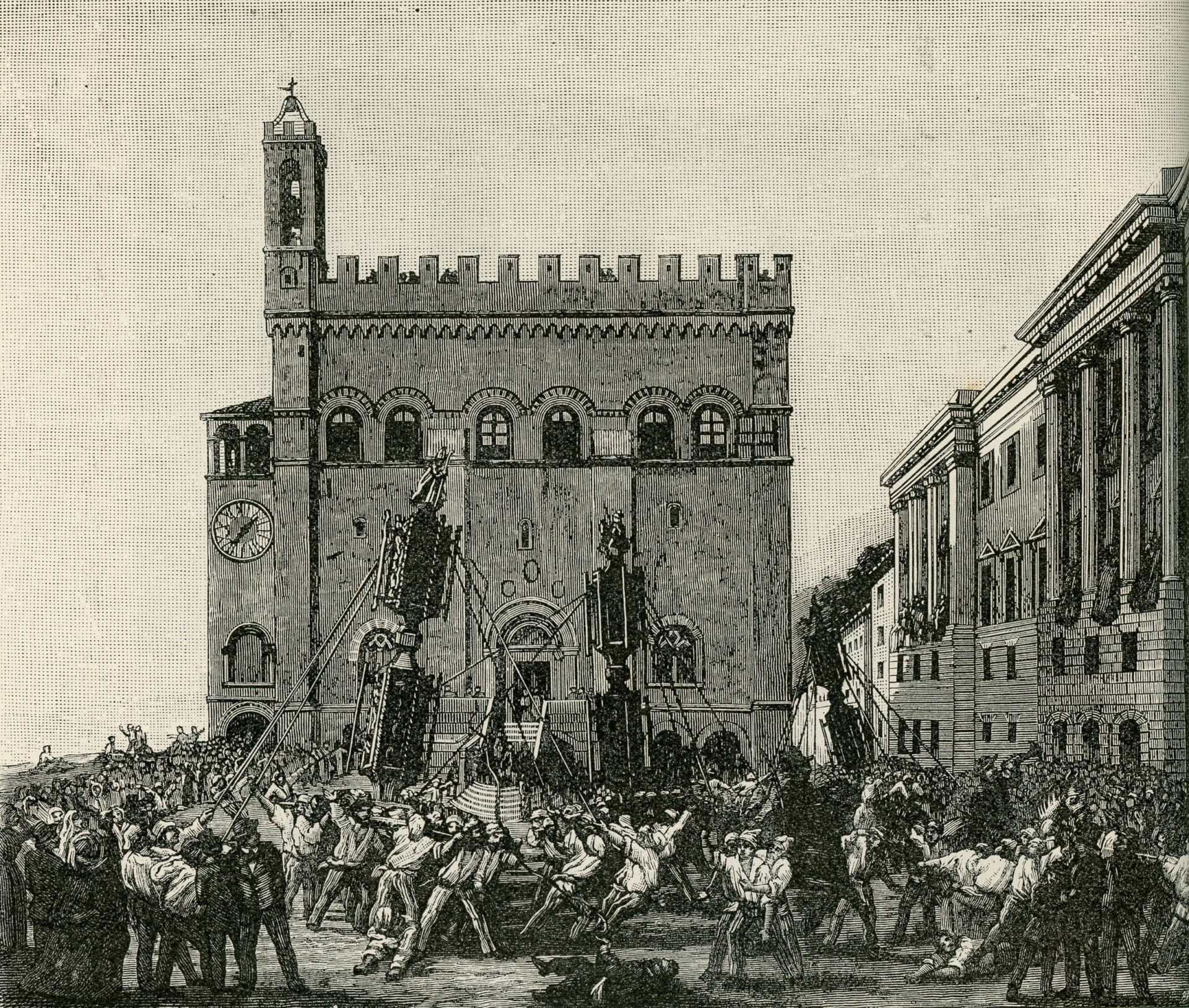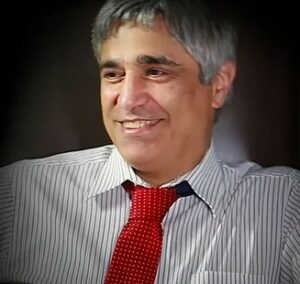A couple of weeks ago, in Jessup, Pennsylvania—the small town next to mine when I was a boy—large crowds of people showed up to celebrate the annual “Race of the Saints,” called in Italian La Corsa dei Ceri, “the Race of the Candles,” because that is what the structures look like. You must imagine, each set and pegged upright on wide and sturdy platforms of wooden beams, three candle-like pedestals as tall and thick as tree-trunks, surmounted by the images of three saints, George, Anthony, and the bishop Ubaldo.
These weigh about 450 pounds each, so you need a team of men to hoist them up on their shoulders, and then to race through the town, up and down the steep streets, while the people associated with each team cheer them on. Of course, the teams must be distinguished by festive garb, bright yellow-gold for Ubaldo, blue for George, and black for Anthony. Since it’s Saint Ubaldo’s feast day, his team must always “win,” but there’s still plenty of competition to see which team makes its way almost to the goal, and which team manages to get the “candles” pegged to the platform first and raised up high.
Why Ubaldo? He was the heroic and saintly bishop of the mountain city of Gubbio, near to Assisi in Umbria, in the twelfth century. Ubaldo was a peace-loving man, somewhat shy and retiring, modest in his garb and manner of life, ever solicitous for the welfare of the poor; but he it was who led the Eugubini in battle against an alliance of nearby cities that had attacked them. When he died, the people venerated him as a saint, and to this day you can view his body in a chapel to which it was transferred four hundred years after his death. I have seen it. It lies in a glass coffin, and the flesh is incorrupt, though stretched taut above the bones.
So the good people of Gubbio have held, for centuries, this same race of the saints, though in Italy the candles weigh about 900 pounds, and the right to be a member of one of the teams is considered a family honor, passed down from fathers to sons. Thousands and thousands throng the streets of the Italian city for the race, in a city-wide festival of piety, tradition, old-fashioned boyish rivalry, feasting, and song. You may then ask why this same feast should be celebrated across the ocean, in Jessup.
And here we encounter something quite unthinkable now—at least in America, and I hope I do not speak for Italy also. The people of Gubbio define themselves by their city. They love the place; they honor their patron; they celebrate their feasts; they know their neighbors; and their neighbors, after all, are probably their kinsmen too, though it might take a careful genealogist to trace two neighboring streams back to their originating source. When the Eugubini emigrated to America, they did not scatter themselves across the continent. What would have been the good of that? Why would they have wanted to do so? The first of them settled in Jessup, to work in the coal mines, and they drew all their kin and neighbors to Jessup after them. Other than the mountainous terrain, there was nothing in Jessup that was like Gubbio. After all, in my own town, Archbald, the Italians emigrated not from Gubbio but from Tiriolo, in Calabria, several hundred miles away.
So then, when the Eugubini came to Jessup, they brought their feast with them, beginning in 1909, though by 1952 it had fallen into abeyance. What brought it back was the surge of traditional feeling that came with the American bicentennial in 1976. That year was the centennial for both Archbald and Jessup, as each borough had been incorporated in 1876. I was a junior in high school then, and my family and I took some part in the big town parade on July 4; the ladies dressed in old-fashioned costumes, and a lot of the men grew beards to boot. But two miles away, some of the elderly Italians got the idea of having the great Race again, and it has continued—with some brief lapses—ever since.
It seems to me that to conceive of such a feast in the first place, three things are of the essence. They are all related. The first is neighborhood born of a felt kinship. I use the word neighborhood in its original sense, when it named not a geographical area but a virtue, that of being a good neighbor—but a short step away from brotherhood. I fear that this may be hard to explain to people who did not grow up with something near to my 39 first cousins, or to my wife’s 43, most of whom we saw quite a lot of, played ball with, rode bicycles with, ate with on a Sunday at our grandparents’ house, went to school with, or to church. In both of those Italian towns, it was as it was also in those Pennsylvania towns, that your neighbors are your cousins, or your cousin’s cousins, or cousins to your cousin’s neighbor, and that means that you all fit in, somehow, and there are no real strangers, at least not after you say your name.
Such people can come together for common work, common play, and common celebration; the second thing that is essential. I said that they can do so, but it really is not so much a possibility as it is the perfectly natural expression of their neighborhood, their belonging to one another. Ever since we were married in 1986, my wife and I have lived in places where you take for granted that people do not know one another, are not related, and therefore they live where they do because of some necessity that has no meaning to the place or to the people in it. When my family and I visited Tiriolo in 1998, some of the elderly women still wore the old traditional garb, even when they were carrying on their heads large baskets of peas and beans up the steep paths leading from the terraced strips of family farmland along the mountainside. To see the dress was to see a woman of the Tiriolese. To wear it was to make a claim: “I belong here, with my people, those who gather the vegetables with me and gossip as we trudge uphill, and those who are buried in the graveyard yonder, where I too will lie someday.”
Which leads me to the third and most essential thing of all. How long a tradition may last without piety properly considered, the duty we owe to God, I do not know. For a while, the tradition endures, perhaps, if we turn it into a draw for tourists, or if we shore it up with much food and drink and noise. Fun is a good thing, and one of the saddest things about daily public life in America is how little of it there is. But fun, to endure, must have its roots in joy, and there is no joy without the divine, what transcends place and time and the individual persons who happen now to be walking the earth. Those people in Gubbio were made one by their devotion to God and their gratitude for the good old bishop. The people in Jessup would not have continued their now literally outlandish feast had it not been for the devotion they still felt, and still exercised in America.
Aim for heaven, said C. S. Lewis, and you get earth into the bargain. Aim for earth, and you lose both. We might put it this way. Look forward to that city not built with human hands, and you will keep your towns in the mountains here. Forget Jerusalem, and you need not trouble yourself about Gubbio and Jessup. They will be but geopolitical fictions.
Image credit: “Gubbio la festa dei Ceri per Sant’Ubaldo” via Wikimedia





